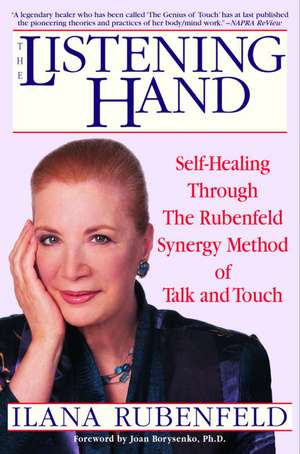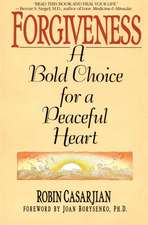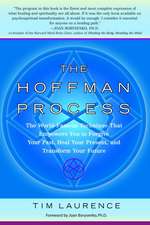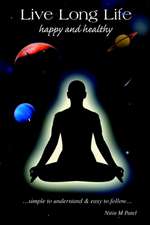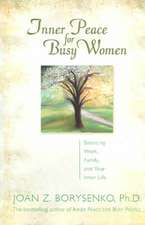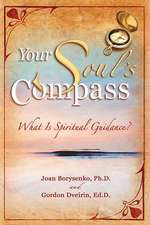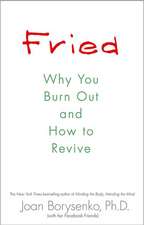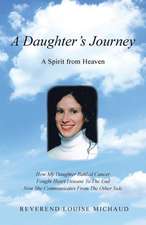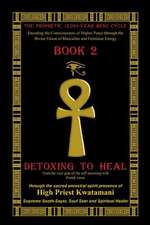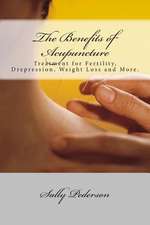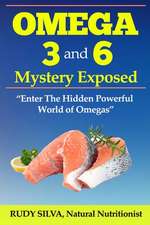The Listening Hand: Self-Healing Through the Rubenfeld Synergy Method of Talk and Touch
Autor Ilana Rubenfeld PhD Borysenko, Joanen Limba Engleză Paperback – 30 sep 2001
The Listening Hand includes:
• Body-mind exercises designed to awaken awareness, free breathing, and reveal the body metaphors that tell your life story
• Guided steps that break through inner barriers and lead to concrete improvements in your daily life and relationships
• Energy explorations for contacting the energy field in yourself and others — and how you can use it to heal
• Experiments for couples that gently increase communication, intimacy, and sexual openness
• Practices that enable helpers to avoid physical, emotional, and spiritual burnout
• A complete 7-day Mind Your Muscles program for tension release, body alignment, and enhanced flexibility
Preț: 116.36 lei
Nou
Puncte Express: 175
Preț estimativ în valută:
22.27€ • 23.00$ • 18.53£
22.27€ • 23.00$ • 18.53£
Carte disponibilă
Livrare economică 04-18 martie
Livrare express 18-22 februarie pentru 52.87 lei
Preluare comenzi: 021 569.72.76
Specificații
ISBN-13: 9780553379839
ISBN-10: 0553379836
Pagini: 288
Dimensiuni: 156 x 237 x 15 mm
Greutate: 0.45 kg
Editura: Bantam
ISBN-10: 0553379836
Pagini: 288
Dimensiuni: 156 x 237 x 15 mm
Greutate: 0.45 kg
Editura: Bantam
Extras
How I Gave Up One Kind of Music for Another
Music saved me.
My mother, Bluma, had a beautiful voice and loved to sing. My father, Leopold, studied as a classical pianist — with the same teacher as Vladimir Horowitz. But he gave it up during the Russian Revolution when he fled Russia for Germany before going on to Palestine.
My mother’s large Orthodox Jewish family also fled Russia, and landed penniless in Paris. My grandmother held them together. She was a baker, and the children sold what she baked. The family’s dream was to live in America, but they were stuck in Europe. Eventually, they were allowed to emigrate to Palestine, which is where my parents met. My mother was slight, with bright blue eyes and long blond hair; she must have been a knockout. My father was brilliant, dynamic and told great jokes. I’m not surprised she was attracted to him. Every second person contracted typhoid in those days, and Father was one of them — while my mother was pregnant with me. He spent many months in the hospital, and she lived with her family. Bluma was very anxious, and I sus-pect she had little time to enjoy her first pregnancy. My early memories are of my mother continually fretting.
When my father finally left the hospital, he had lost a great deal of weight and his zest for life. Somehow, though, he kept his sense of humor, and there were times when mother sang and he accompanied her. But on the whole the atmosphere in the house was dark.
Happier times were spent with my mother’s sisters. With them there were laughter, games, songs — and physical affection. My first loving touch came from my aunt Hannah — Mother Earth; without her I think I would have been in serious trouble. Maybe it was with her that I first learned the importance of being held, bonding, connectedness and touch. Maybe it was because of her that I learned you did not need words to communicate.
My father was offered a good job in Paris, but our exhilaration was short-lived, for he got seriously sick again and by the time he was well enough the position was gone. He was promised a job in the U.S.A. and decided to go. Bluma did not want to leave her clan, but her father told her that a good wife always followed her husband. So she and I sailed for America. We were lucky. We were on the last boat to leave Palestine for New York until after the war. A few weeks after we sailed, Tel Aviv was bombed. The house and dreams of my childhood and those of all our friends were blown to pieces.
I was not yet six years old. When I came to New York, I had no one to turn to. My father was struggling to get work, so I barely saw him at all. My mother was in a state of shock and deeply depressed. I didn’t understand or speak English, and there was no one at home to help me. School, of course, was taught in English. For months I sat in the first-grade classroom, not understanding a word. It was frightening, frustrating and mortifying. This experience shaped my life and later my career. I had to decipher the true meaning of what was being said from body language — posture, gestures, movements, facial expressions and voice tone. This skill al-lowed me to see behind words and hear their true meaning. It became clear that contradicting messages were being given when the words said one thing, the body quite another.
From home to school and back was a harrowing daily journey through a religious Irish-Catholic neighborhood. I was pelted with rock-filled snowballs while my tormentors shouted “Christ-killer.” What a sad and painful time it was for a little silent Jewish girl plodding to and from a school where she understood no one to a home where no one understood her.
I pleaded with my mother to explain what a “Christ-killer” was. Somehow I was to blame for His death. My mother, flustered as well, tried her best to assure me I was not His murderer. But to no avail.
The torment and the emotional wounding continued. I missed the Mediterranean Sea, the trees of Tel Aviv and, most of all, my extended family. My mother cried, and I remember fighting not to imitate her. I was a displaced person. Lost.
Then someone made a donation to our family worth more to me than the crown jewels of Russia.
A piano.
If nothing else, the piano brought me and my father together. He played and I listened. How I treasured the sound! He played Russian music and Chopin. As a child, I loved Snow White and Donald Duck, but by the time I was a teenager it was the mazurkas and The Rite of Spring.
My parents sent me to a Catholic summer camp to get me out of New York, which they were sure was in danger of imminent attack. It was there that I continued to learn English by having to say my Hail Mary every morning and the Lord’s Prayer at night.
The counselors quickly discovered I had a good ear and a nice voice. I would run to the camp piano and play for hours. I couldn’t read music but I could compose it, and in time I composed the music for the camp play and directed it. At age eight I was already a conductor!
Every Russian mother believes that little girls should study ballet, so mine enrolled me in a class on Saturday mornings. Yolishka, a traditional Russian ballet teacher, hit the floor and her pupils with a long wooden stick. There was always a reward afterward: my mother would take me to a Hungarian restaurant for stuffed cabbage, and then to a matinee of ballet at the New York City Center. It was our ritual, our closest contact.
My father frowned on music lessons because they were impractical, and he insisted I learn how to type. He repeatedly said that there would always be a secure job — something he never really had — for a typist.
News of relations killed in Europe trickled in at first, then began to arrive more frequently. I was terribly upset by what I heard, and pictures I saw. The time of the Holocaust haunted me. Years later, as a beginning therapist, I had trouble separating from my own angst when I treated camp survivors.
I was constantly badgering my parents with questions.
For my father:
How could the Germans produce Beethoven yet kill all those innocent people?
How could God let little children be killed?
How could there be concentration camps if there was a God?
For my mother:
How come you are so unhappy?
My parents couldn’t answer, and my frustration with them grew. Then, when I was twelve, my sister Lydia was born. My mother immediately went into a profound depression and disappeared from home. It was not until much later that I learned she had been hospitalized.
I was left to take care of my sister, and became her little mother. When my mother returned, I took care of her, too. Now I was both my parents’ mother and my sister’s mother — as well as a student at junior high school.
It was at the High School of Music and Art that I began to develop a love of conducting. I also learned to play the viola, a tough instrument for a young girl, requiring strength and a strange sitting position. I began developing the back problems that had a great influence on my exchanging a career in music for a career in bodywork.
During these teenage years, I also joined a Jewish scout organization that believed American Jews should return to Israel to become farmers. One day the conductor of the scout choir got sick. “You go to Music and Art,” I was told. “You be the conductor.” It was both a frightening command and music to my ears.
Before starting college, I did go to Israel to work on a farm and study. I wanted to take care of the earth, making the world a better place to live. (I also conducted choral concerts of simple folk music.) It was an attempt to find my roots. I came back feeling more whole and more grounded than at any previous time in my life.
When I returned to the States, I went first to the Manhattan School of Music, but I transferred to Juilliard because there I could major in conducting.
One voice at a time, I told myself. Soprano, alto, tenor, bass. Strings, woodwinds, tympani, brass, etc. Then put the parts together.
Soon I was able to hear the whole from the sum of its parts and then I learned to transmit this vision to the players, not through verbal commands but by using my face, my body and especially my hands. I could cradle the music, hold it in my hands and hold it out to the players. My hands could both listen and speak.
Through conducting, I came to understand the complexities of listening, talking and moving simultaneously. Like music, healing involves the capacity to listen to others and hear their inner song. Hearing silence as well as sounds is part of music, so the healer learns to listen to both sounds and silences. Impulses, needs, emotions and feelings in people are expressed through sounds and silences, words and wordless movements of the body. The healer listens to all these variations and helps the client achieve harmony.
This notion of emotional orchestration coalesced for me when I conducted Vivaldi’s Gloria Mass. Standing at center stage, I became a musical and spiritual bridge between the singers in front of me and the audience behind. As we began the second movement, “et in terra pax homnibus” (“and on this earth, let us have peace”), a life-shaping event occurred. The music became extremely intense, and I left my physical body and in a spiral movement floated up to the ceiling. Surprised, I looked down. I saw my parents, my teachers, my friends, and I watched myself conducting. I was both inside and outside the musical notes on the page, experiencing the sounds they made, becoming one with the energy of the music. I was utterly at peace; in heaven.
Suddenly, the cello section came in a measure too soon, and I was hurtled back into my body to rectify the mistake. As the last chords ended the magnificent “Sanctus,” I turned around to face the audience and bowed. I saw their hands applauding, and yet there was no sound. Backstage, people talked, but I didn’t hear them. I smiled. Everyone looked beautiful. I was still at peace.
It was several days before I realized that I had undergone a deeply religious out-of-body experience and had altered my state of consciousness. Leaving my body both frightened me and inspired me. It was a spiritual, peaceful and egoless state. As the conductor/bridge, I was making the music happen, but also stepping aside from it, letting it happen on its own, listening to it happen, hearing it happen. I became an insignificant part of the music’s energy, and also essential to it. I had re-created it, but it had also re-created me.
This same state of ego and egolessness, of insignificance and essence, is true in regard to cosmic energy, of which music is a magnificent expression, for we are all insignificant, essential parts of the cosmic sphere, part of the ascending spiral. And it is true in regard to my therapeutic work with people.
When I’m with clients, I feel that I am in that egoless state. I am still Ilana, yet different: nonjudgmental, totally accepting, loving. I can be both a partner in the therapeutic experience and step aside from it. You sing your own song. I am a vital guide to help you hear and understand it, and to accept your body as your musical score.
The tools I use for my therapeutic work — to let you hear your authentic self — are my brain and my hands. For as I learned early on, and shall describe in detail in the following chapters, emotions and feelings are embedded both in our body and in our brain, and to reach them, we need touch — nonverbal communication — and talk. Through touch you can understand the body’s message, and through talk you can understand the brain’s, even if the message is “hiding” in the unconscious. Body and brain are equally revelatory. Together they send meaning that through either alone is incomplete.
Fritz Perls, the co-founder of Gestalt therapy, insisted that I was a com-poser as well as a conductor. In a way, he was right. A conductor takes other people’s music and brings life to it. Composers create unique forms of music. I composed the Rubenfeld Synergy Method, which has a unique music of its own.
Conducting for many hours a day challenged me physically. At that time, at Juilliard, no one had taught me how to use my body efficiently. After graduating, I accepted an assistant conducting job with Leopold Stokowski, and another position as a conductor in the 92nd St. YM-YWHA music department. The pain which had begun when I was learning the viola now returned with redoubled force. As I was preparing for a concert, my back and shoulders went into spasm. I couldn’t lift my right arm — for a conductor, a disaster.
Various doctors prescribed medications that gave me only temporary relief. I could get through a concert, but the pain quickly returned. Desperate, I began looking for other ways of treating my condition. A musician friend suggested that I try the F. M. Alexander Technique, a method designed to teach balanced and efficient posture. The therapist he recommended was a woman named Judy Leibowitz, the only person teaching the Alexander Technique at the time. I made an appointment — and, in the very first session, found my true vocation.
The revelations I experienced in Judy’s office were as powerful in their way as those I’d had when I was conducting the Vivaldi Mass. They led me to a se-ries of revelations (I call them “Ahas”) that have become the foundation of the Rubenfeld Synergy Method. I’ll describe them in the next chapter, and you’ll see them in action throughout the book.
For the purposes of this brief autobiography, however, the important factor was that by studying and applying the Alexander Technique I was able to resume conducting without debilitating discomfort.
Although the pain had disappeared, I continued working with Judy. Now it was not pain that prevented my conducting, but the fact that I was a woman. I had made a promising start, conducting at Carnegie Hall and at Town Hall. But time and again I was turned down for jobs because I was female. If I had a penis, I thought, I’d be assisting Pierre Monteux, who refused even to accept me in his conducting class. “I don’t teach women conducting!” he wrote in response to my application.
Gradually, as my interest in the Alexander Technique increased, the pain of rejection diminished. Judy encouraged me to become a teacher, and for a time I worked actively in both fields, music and bodywork.
Although I wasn’t a psychotherapist yet, I was convinced that posture and touch played an important role in accessing emotions. In the process of one’s changing posture, emotions were being shunted aside by the body, hidden and not dealt with. Yet there were emotions, I was convinced, frozen along with the memories that elicited them in the tissue of the body as well as in the mind.
In the mid-1960s, I met Fritz and Laura Perls. Fritz was teaching a small group at the Esalen Institute, and he became a mentor to me. It was through his teaching that I added more psychotherapy to my own therapeutic theories. He invited me to use touch with his clients while he talked to them. I soon reconfirmed that there was a subtle and clear muscular response to every thought and emotion that people felt. And I learned that touch could open gateways to the mind.
It was at the Esalen Institute that Moshe Feldenkrais began to train and teach a few of us. For the following eight years I trained in his two-tiered method of Functional Integration and Awareness Through Movement, while I continued to follow my own explorations.
Both the Alexander Technique and Feldenkrais’s method taught people how to release tense habitual patterns held in the body. Neither, however, addressed the emotions behind those patterns, or their often vivid expressions when the patterns were unlocked. Conventional psychotherapy relied on talking through problems, and the bodywork addressed their physical aspects. To me, these disparate approaches were fragmented, denying the unity of the body, mind and emotions.
In the 1930s, the controversial psychiatrist Wilhelm Reich had espoused the same concept of combining bodywork with psychoanalysis. He believed that emotions are held in the body, “blocked” there by “armor” which prevents their release. He emphasized that all living creatures have energy and that when this energy is blocked, it causes the life force to diminish, resulting in characterological defenses that rob the client of freedom and authenticity. Reich used intense, deep-pressured touch to “break” that armor. I found that using light, nonintrusive touch “melted” the armor. The goal was the same: the release of emotion and feeling to allow the client to become his/her full energetic self.
Putting mind and body therapy together was as exciting as making music — quite literally, it was the discovery of harmony of a different sort.
I realized that for people to understand their emotional state, they would have to learn how to listen to their bodies. While observation and talk are valid tools, one of the most powerful ways to heal is through the use of touch. Often, emotions are beyond words; they are not linear or rational. Hands are the most sensitive receptors of the subtleties of sensation. I learned — and you can learn — to develop “listening hands” in order to “hear” changes in the body.
Listening touch became my instrument for tuning into all levels of the psyche. Touch and talk became an essential duet; here were two great healing forces that when synergized were greater than either alone.
The medical meaning of the word “synergy” is “a remedy acting similarly to another remedy and increasing its efficiency when combined with it.” It was Buckminster Fuller who suggested that it was appropriate to call my work Rubenfeld Synergy and to call myself a Synergist. Semantics, perhaps, but it expresses the basis of this work, because I strongly believe that everything — mind and body, thoughts, emotions and feelings, bloodstream and brain, soul and spirit — must be in a state of synergy if we ourselves are to become whole.
The word slowly spread that mine was an effective approach. People with many different needs and backgrounds began to come to my office. I worked with world-famous performers, other therapists, the wife of a president — and many other people who longed to be balanced and well.
In these beginning years, I was frequently approached to write a book about this new approach. However, I was still refining the theories and philosophies, and developing exercises that anyone could do. Life force and energetic concepts were difficult to translate onto paper. Only recently have scientists begun to document the interaction of mind, body and emotions.
At the beginning of the twenty-first century, the way to healing has become less fractionalized; bringing the body, mind and spirit into a congruent whole is more common than it was even ten years ago. I write this book now because I can illustrate what happens in the healing process, and by so doing show you the way to self-healing. I will teach you about the way your body holds emotion and the methods for releasing it; about your energy field, which is the basis for therapeutic touch; about the use of gentle, healing touch; and about the all-important factor of awareness, which is the first step toward change. This book will provide you with ample instruction and exercises for you to experience change and adopt it into your life.
It is meant to inspire. It is meant to help you understand your emotional body, and to help others understand theirs.
Music saved me.
My mother, Bluma, had a beautiful voice and loved to sing. My father, Leopold, studied as a classical pianist — with the same teacher as Vladimir Horowitz. But he gave it up during the Russian Revolution when he fled Russia for Germany before going on to Palestine.
My mother’s large Orthodox Jewish family also fled Russia, and landed penniless in Paris. My grandmother held them together. She was a baker, and the children sold what she baked. The family’s dream was to live in America, but they were stuck in Europe. Eventually, they were allowed to emigrate to Palestine, which is where my parents met. My mother was slight, with bright blue eyes and long blond hair; she must have been a knockout. My father was brilliant, dynamic and told great jokes. I’m not surprised she was attracted to him. Every second person contracted typhoid in those days, and Father was one of them — while my mother was pregnant with me. He spent many months in the hospital, and she lived with her family. Bluma was very anxious, and I sus-pect she had little time to enjoy her first pregnancy. My early memories are of my mother continually fretting.
When my father finally left the hospital, he had lost a great deal of weight and his zest for life. Somehow, though, he kept his sense of humor, and there were times when mother sang and he accompanied her. But on the whole the atmosphere in the house was dark.
Happier times were spent with my mother’s sisters. With them there were laughter, games, songs — and physical affection. My first loving touch came from my aunt Hannah — Mother Earth; without her I think I would have been in serious trouble. Maybe it was with her that I first learned the importance of being held, bonding, connectedness and touch. Maybe it was because of her that I learned you did not need words to communicate.
My father was offered a good job in Paris, but our exhilaration was short-lived, for he got seriously sick again and by the time he was well enough the position was gone. He was promised a job in the U.S.A. and decided to go. Bluma did not want to leave her clan, but her father told her that a good wife always followed her husband. So she and I sailed for America. We were lucky. We were on the last boat to leave Palestine for New York until after the war. A few weeks after we sailed, Tel Aviv was bombed. The house and dreams of my childhood and those of all our friends were blown to pieces.
I was not yet six years old. When I came to New York, I had no one to turn to. My father was struggling to get work, so I barely saw him at all. My mother was in a state of shock and deeply depressed. I didn’t understand or speak English, and there was no one at home to help me. School, of course, was taught in English. For months I sat in the first-grade classroom, not understanding a word. It was frightening, frustrating and mortifying. This experience shaped my life and later my career. I had to decipher the true meaning of what was being said from body language — posture, gestures, movements, facial expressions and voice tone. This skill al-lowed me to see behind words and hear their true meaning. It became clear that contradicting messages were being given when the words said one thing, the body quite another.
From home to school and back was a harrowing daily journey through a religious Irish-Catholic neighborhood. I was pelted with rock-filled snowballs while my tormentors shouted “Christ-killer.” What a sad and painful time it was for a little silent Jewish girl plodding to and from a school where she understood no one to a home where no one understood her.
I pleaded with my mother to explain what a “Christ-killer” was. Somehow I was to blame for His death. My mother, flustered as well, tried her best to assure me I was not His murderer. But to no avail.
The torment and the emotional wounding continued. I missed the Mediterranean Sea, the trees of Tel Aviv and, most of all, my extended family. My mother cried, and I remember fighting not to imitate her. I was a displaced person. Lost.
Then someone made a donation to our family worth more to me than the crown jewels of Russia.
A piano.
If nothing else, the piano brought me and my father together. He played and I listened. How I treasured the sound! He played Russian music and Chopin. As a child, I loved Snow White and Donald Duck, but by the time I was a teenager it was the mazurkas and The Rite of Spring.
My parents sent me to a Catholic summer camp to get me out of New York, which they were sure was in danger of imminent attack. It was there that I continued to learn English by having to say my Hail Mary every morning and the Lord’s Prayer at night.
The counselors quickly discovered I had a good ear and a nice voice. I would run to the camp piano and play for hours. I couldn’t read music but I could compose it, and in time I composed the music for the camp play and directed it. At age eight I was already a conductor!
Every Russian mother believes that little girls should study ballet, so mine enrolled me in a class on Saturday mornings. Yolishka, a traditional Russian ballet teacher, hit the floor and her pupils with a long wooden stick. There was always a reward afterward: my mother would take me to a Hungarian restaurant for stuffed cabbage, and then to a matinee of ballet at the New York City Center. It was our ritual, our closest contact.
My father frowned on music lessons because they were impractical, and he insisted I learn how to type. He repeatedly said that there would always be a secure job — something he never really had — for a typist.
News of relations killed in Europe trickled in at first, then began to arrive more frequently. I was terribly upset by what I heard, and pictures I saw. The time of the Holocaust haunted me. Years later, as a beginning therapist, I had trouble separating from my own angst when I treated camp survivors.
I was constantly badgering my parents with questions.
For my father:
How could the Germans produce Beethoven yet kill all those innocent people?
How could God let little children be killed?
How could there be concentration camps if there was a God?
For my mother:
How come you are so unhappy?
My parents couldn’t answer, and my frustration with them grew. Then, when I was twelve, my sister Lydia was born. My mother immediately went into a profound depression and disappeared from home. It was not until much later that I learned she had been hospitalized.
I was left to take care of my sister, and became her little mother. When my mother returned, I took care of her, too. Now I was both my parents’ mother and my sister’s mother — as well as a student at junior high school.
It was at the High School of Music and Art that I began to develop a love of conducting. I also learned to play the viola, a tough instrument for a young girl, requiring strength and a strange sitting position. I began developing the back problems that had a great influence on my exchanging a career in music for a career in bodywork.
During these teenage years, I also joined a Jewish scout organization that believed American Jews should return to Israel to become farmers. One day the conductor of the scout choir got sick. “You go to Music and Art,” I was told. “You be the conductor.” It was both a frightening command and music to my ears.
Before starting college, I did go to Israel to work on a farm and study. I wanted to take care of the earth, making the world a better place to live. (I also conducted choral concerts of simple folk music.) It was an attempt to find my roots. I came back feeling more whole and more grounded than at any previous time in my life.
When I returned to the States, I went first to the Manhattan School of Music, but I transferred to Juilliard because there I could major in conducting.
One voice at a time, I told myself. Soprano, alto, tenor, bass. Strings, woodwinds, tympani, brass, etc. Then put the parts together.
Soon I was able to hear the whole from the sum of its parts and then I learned to transmit this vision to the players, not through verbal commands but by using my face, my body and especially my hands. I could cradle the music, hold it in my hands and hold it out to the players. My hands could both listen and speak.
Through conducting, I came to understand the complexities of listening, talking and moving simultaneously. Like music, healing involves the capacity to listen to others and hear their inner song. Hearing silence as well as sounds is part of music, so the healer learns to listen to both sounds and silences. Impulses, needs, emotions and feelings in people are expressed through sounds and silences, words and wordless movements of the body. The healer listens to all these variations and helps the client achieve harmony.
This notion of emotional orchestration coalesced for me when I conducted Vivaldi’s Gloria Mass. Standing at center stage, I became a musical and spiritual bridge between the singers in front of me and the audience behind. As we began the second movement, “et in terra pax homnibus” (“and on this earth, let us have peace”), a life-shaping event occurred. The music became extremely intense, and I left my physical body and in a spiral movement floated up to the ceiling. Surprised, I looked down. I saw my parents, my teachers, my friends, and I watched myself conducting. I was both inside and outside the musical notes on the page, experiencing the sounds they made, becoming one with the energy of the music. I was utterly at peace; in heaven.
Suddenly, the cello section came in a measure too soon, and I was hurtled back into my body to rectify the mistake. As the last chords ended the magnificent “Sanctus,” I turned around to face the audience and bowed. I saw their hands applauding, and yet there was no sound. Backstage, people talked, but I didn’t hear them. I smiled. Everyone looked beautiful. I was still at peace.
It was several days before I realized that I had undergone a deeply religious out-of-body experience and had altered my state of consciousness. Leaving my body both frightened me and inspired me. It was a spiritual, peaceful and egoless state. As the conductor/bridge, I was making the music happen, but also stepping aside from it, letting it happen on its own, listening to it happen, hearing it happen. I became an insignificant part of the music’s energy, and also essential to it. I had re-created it, but it had also re-created me.
This same state of ego and egolessness, of insignificance and essence, is true in regard to cosmic energy, of which music is a magnificent expression, for we are all insignificant, essential parts of the cosmic sphere, part of the ascending spiral. And it is true in regard to my therapeutic work with people.
When I’m with clients, I feel that I am in that egoless state. I am still Ilana, yet different: nonjudgmental, totally accepting, loving. I can be both a partner in the therapeutic experience and step aside from it. You sing your own song. I am a vital guide to help you hear and understand it, and to accept your body as your musical score.
The tools I use for my therapeutic work — to let you hear your authentic self — are my brain and my hands. For as I learned early on, and shall describe in detail in the following chapters, emotions and feelings are embedded both in our body and in our brain, and to reach them, we need touch — nonverbal communication — and talk. Through touch you can understand the body’s message, and through talk you can understand the brain’s, even if the message is “hiding” in the unconscious. Body and brain are equally revelatory. Together they send meaning that through either alone is incomplete.
Fritz Perls, the co-founder of Gestalt therapy, insisted that I was a com-poser as well as a conductor. In a way, he was right. A conductor takes other people’s music and brings life to it. Composers create unique forms of music. I composed the Rubenfeld Synergy Method, which has a unique music of its own.
Conducting for many hours a day challenged me physically. At that time, at Juilliard, no one had taught me how to use my body efficiently. After graduating, I accepted an assistant conducting job with Leopold Stokowski, and another position as a conductor in the 92nd St. YM-YWHA music department. The pain which had begun when I was learning the viola now returned with redoubled force. As I was preparing for a concert, my back and shoulders went into spasm. I couldn’t lift my right arm — for a conductor, a disaster.
Various doctors prescribed medications that gave me only temporary relief. I could get through a concert, but the pain quickly returned. Desperate, I began looking for other ways of treating my condition. A musician friend suggested that I try the F. M. Alexander Technique, a method designed to teach balanced and efficient posture. The therapist he recommended was a woman named Judy Leibowitz, the only person teaching the Alexander Technique at the time. I made an appointment — and, in the very first session, found my true vocation.
The revelations I experienced in Judy’s office were as powerful in their way as those I’d had when I was conducting the Vivaldi Mass. They led me to a se-ries of revelations (I call them “Ahas”) that have become the foundation of the Rubenfeld Synergy Method. I’ll describe them in the next chapter, and you’ll see them in action throughout the book.
For the purposes of this brief autobiography, however, the important factor was that by studying and applying the Alexander Technique I was able to resume conducting without debilitating discomfort.
Although the pain had disappeared, I continued working with Judy. Now it was not pain that prevented my conducting, but the fact that I was a woman. I had made a promising start, conducting at Carnegie Hall and at Town Hall. But time and again I was turned down for jobs because I was female. If I had a penis, I thought, I’d be assisting Pierre Monteux, who refused even to accept me in his conducting class. “I don’t teach women conducting!” he wrote in response to my application.
Gradually, as my interest in the Alexander Technique increased, the pain of rejection diminished. Judy encouraged me to become a teacher, and for a time I worked actively in both fields, music and bodywork.
Although I wasn’t a psychotherapist yet, I was convinced that posture and touch played an important role in accessing emotions. In the process of one’s changing posture, emotions were being shunted aside by the body, hidden and not dealt with. Yet there were emotions, I was convinced, frozen along with the memories that elicited them in the tissue of the body as well as in the mind.
In the mid-1960s, I met Fritz and Laura Perls. Fritz was teaching a small group at the Esalen Institute, and he became a mentor to me. It was through his teaching that I added more psychotherapy to my own therapeutic theories. He invited me to use touch with his clients while he talked to them. I soon reconfirmed that there was a subtle and clear muscular response to every thought and emotion that people felt. And I learned that touch could open gateways to the mind.
It was at the Esalen Institute that Moshe Feldenkrais began to train and teach a few of us. For the following eight years I trained in his two-tiered method of Functional Integration and Awareness Through Movement, while I continued to follow my own explorations.
Both the Alexander Technique and Feldenkrais’s method taught people how to release tense habitual patterns held in the body. Neither, however, addressed the emotions behind those patterns, or their often vivid expressions when the patterns were unlocked. Conventional psychotherapy relied on talking through problems, and the bodywork addressed their physical aspects. To me, these disparate approaches were fragmented, denying the unity of the body, mind and emotions.
In the 1930s, the controversial psychiatrist Wilhelm Reich had espoused the same concept of combining bodywork with psychoanalysis. He believed that emotions are held in the body, “blocked” there by “armor” which prevents their release. He emphasized that all living creatures have energy and that when this energy is blocked, it causes the life force to diminish, resulting in characterological defenses that rob the client of freedom and authenticity. Reich used intense, deep-pressured touch to “break” that armor. I found that using light, nonintrusive touch “melted” the armor. The goal was the same: the release of emotion and feeling to allow the client to become his/her full energetic self.
Putting mind and body therapy together was as exciting as making music — quite literally, it was the discovery of harmony of a different sort.
I realized that for people to understand their emotional state, they would have to learn how to listen to their bodies. While observation and talk are valid tools, one of the most powerful ways to heal is through the use of touch. Often, emotions are beyond words; they are not linear or rational. Hands are the most sensitive receptors of the subtleties of sensation. I learned — and you can learn — to develop “listening hands” in order to “hear” changes in the body.
Listening touch became my instrument for tuning into all levels of the psyche. Touch and talk became an essential duet; here were two great healing forces that when synergized were greater than either alone.
The medical meaning of the word “synergy” is “a remedy acting similarly to another remedy and increasing its efficiency when combined with it.” It was Buckminster Fuller who suggested that it was appropriate to call my work Rubenfeld Synergy and to call myself a Synergist. Semantics, perhaps, but it expresses the basis of this work, because I strongly believe that everything — mind and body, thoughts, emotions and feelings, bloodstream and brain, soul and spirit — must be in a state of synergy if we ourselves are to become whole.
The word slowly spread that mine was an effective approach. People with many different needs and backgrounds began to come to my office. I worked with world-famous performers, other therapists, the wife of a president — and many other people who longed to be balanced and well.
In these beginning years, I was frequently approached to write a book about this new approach. However, I was still refining the theories and philosophies, and developing exercises that anyone could do. Life force and energetic concepts were difficult to translate onto paper. Only recently have scientists begun to document the interaction of mind, body and emotions.
At the beginning of the twenty-first century, the way to healing has become less fractionalized; bringing the body, mind and spirit into a congruent whole is more common than it was even ten years ago. I write this book now because I can illustrate what happens in the healing process, and by so doing show you the way to self-healing. I will teach you about the way your body holds emotion and the methods for releasing it; about your energy field, which is the basis for therapeutic touch; about the use of gentle, healing touch; and about the all-important factor of awareness, which is the first step toward change. This book will provide you with ample instruction and exercises for you to experience change and adopt it into your life.
It is meant to inspire. It is meant to help you understand your emotional body, and to help others understand theirs.
Notă biografică
ILANA RUBENFELD, Ph.D., currently teaches at the Esalen and Omega Institutes and at the New York Open Center. She has also been on the faculties of the NYU Graduate School of Social Work and the New School for Social Research. She gives lectures and workshops nationwide and conducts a four-year professional certification training program.
From the Hardcover edition.
From the Hardcover edition.
Recenzii
“A legendary healer who has been called ‘The Genius of Touch’ has at last published the pioneering theories and practices of her body/mind work.”
— NAPRA ReView
“A classic.”
— Belleruth Naparstek, author of Your Sixth Sense
“About thirty years ago Ilana Rubenfeld discovered that emotions reside and are held in the body, and that skillful touch combined with talk could release emotions and heal pain, thus freeing people to live healthier, more effective lives. In The Listening Hand Ilana has distilled the essence of her unique approach.”
— Christiane Northrup, M.D., author of Women’s Bodies, Women’s Wisdom
“Ilana is truly a woman with healing intuitive gifts.”
— Judy Collins, singer, composer, and author
“As productive as it is profound.”
— Jean Houston, author of Jump Time
— NAPRA ReView
“A classic.”
— Belleruth Naparstek, author of Your Sixth Sense
“About thirty years ago Ilana Rubenfeld discovered that emotions reside and are held in the body, and that skillful touch combined with talk could release emotions and heal pain, thus freeing people to live healthier, more effective lives. In The Listening Hand Ilana has distilled the essence of her unique approach.”
— Christiane Northrup, M.D., author of Women’s Bodies, Women’s Wisdom
“Ilana is truly a woman with healing intuitive gifts.”
— Judy Collins, singer, composer, and author
“As productive as it is profound.”
— Jean Houston, author of Jump Time
